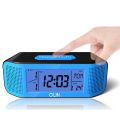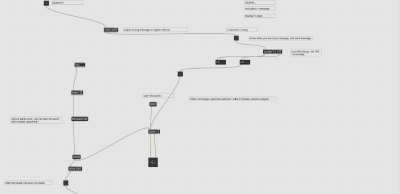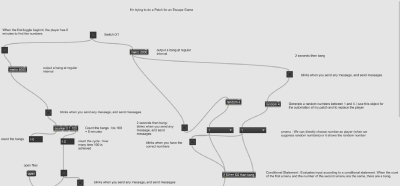|
|
| (42 intermediate revisions by 3 users not shown) |
| Line 1: |
Line 1: |
| *[[My first patches]]
| | ==Idea #1== |
| | A program to relieve pain through electrotherapy |
|
| |
|
| | This project was developed with Serena Bedim and Marie Acker. However, the project was too ambitious. On this page you will find information related to the suppression of pain by electrotherapy. |
|
| |
|
| What we have to know about Electrotherapy (measure, indicators and how does it work)
| | The aim of project is to relieve pain which controls by muscle tension by using Electromyography Sensor (EMG). |
|
| |
|
| Electrotherapy made simple : https://www.youtube.com/watch?v=JAPU5iEfFVY
| | Arduino sketch: [[:File:Idee 2 - 3 LEDS.ino]]. It doesn't work. |
|
| |
|
| '''What is Electrotherapy ?'''
| | ===Sketch to receive the pulses of the patch=== |
|
| |
|
| Electrotherapy is the use of electrical energy as a medical treatment. In medicine, the term electrotherapy can apply to a variety of treatments, including the use of electrical devices such as deep brain stimulators for neurological disease. When you feel nerve pain, an electrical signal is sent from a damaged nerve to your brain. Electrical stimulation for nerve pain works by sending out its own electrical impulses. These charges seem to interrupt or block the pain signals, reducing the pain you feel.
| | These pictures represent the project because they show how the muscle will be link with the computer. |
|
| |
|
| Electrotherapy units usually consist of a battery-powered device connected by wires to adhesive electrode pads which are placed on the skin. The electrode pads are sticky, so they will adhere to the skin. Once the electrodes are attached and the unit is turned on, a mild electric current is sent to the skin via the electrode. A number of newer electrotherapy devices bypass the wires, combining electrodes and battery power into a single unit that can be worn inconspicuously on the back, arm, leg, or elsewhere during work or other daily activities. A hand-held controller is used to adjust the level of stimulation.
| | <gallery> |
| | File:400px-B05037_01_04-1.jpg |
| | File:Exemple.jpg |
| | </gallery> |
|
| |
|
| You will need to use the TENS for about 30 minutes to reach maximum affect and it will last about 30 minutes after the TENS has been switched off. How long should a TENS machine be used for? The TENS machine can be used for as long as desired, typically 30 minutes up to 2 hours, several times a day if needed.
| | ===Further research=== |
| | On this page are my research on this topic [[/My research]] |
|
| |
|
| You can begin with one 15-minute therapy session. Repeat for another 15 minutes if needed. Use up to three times per day at a maximum. During each therapy, rate your pain before and after the session, 1 (low) to 10 (high) in order to gauge the true reduction of pain.
| | ==Idea #2== |
| | Alarm clock |
|
| |
|
| '''Types of Electrotherapy'''
| | <gallery> |
| | File:réveil.jpg |
| | </gallery> |
|
| |
|
| All electrotherapy devices have certain similarities, such as using battery power to apply current to electrodes. The therapies vary in frequencies, waveforms, and effects, however. These are some of the most commonly used kinds of electrotherapy:
| | I tried to create a program that looked like an alarm clock. The sound is triggered after a certain time. The last program is the final program. Like an alarm clock of the phone, you have to choose the music. Then, you can start the patch. When the music start, you can stop it (to sleep a little longer). After a certain time, the music start again. |
|
| |
|
| Transcutaneous electrical nerve stimulation (TENS)
| | The aim of this project is to create an alarm clock with a button "snooze". To stop music and replace the button "snooze", I use the space bar. |
| Percutaneous electrical nerve stimulation (PENS)
| |
| Electrical muscle stimulation (EMS)
| |
| Interferential current (IFC)
| |
| Pulsed electromagnetic field therapy (PEMF)
| |
| Galvanic stimulation (GS)
| |
|
| |
|
| The machines are rather simple to use. First off, you need to make sure there is a full battery in the machine. Second, figure out which knob does what. The first one should change the strength of the electrical signal, while the second changes the speed making it faster or slower. Next, clean your skin with rubbing alcohol and let it dry before applying the electrodes. While it's drying, put the gel on the bottom of the electrodes, it will help the electrical signals reach the nerves.
| | This picture represents my patch because it shows the alarm clock I wanted to create. The human can stop the alarm clock or click on the button to sleep a little longer : the music will start again, after a certain time |
| Finally, attach the electrodes to your skin using a sticky patch or medical tape. Cover the electrode fully so it will stay in place, if you can't reach the area, ask someone for assistance. Once in place, hook the connectors to the ends and turn on the TENS unit. As you turn it on, slowly adjust the settings. Always start with your TENS machine on the lowest setting possible and raise it as needed. Your skin should feel tingly.
| |
|
| |
|
| '''How does reduce pain?'''
| | Here is a picture of my patch. As in the other photo, you can have an alarm clock with a button "snooze". |
|
| |
|
| The ‘Gate Control’ theory was first proposed in 1965. The main concept of this theory is that the brain can only pay attention to one stimulus (or message) at a time. When a painful stimulus causes a pain receptor (specialized cell that detects painful stimuli) to send a message to the brain via a ‘pain nerve’, the brain perceives that message as ‘pain’. Similarly, if a touch receptor is stimulated, a message is sent to the brain by a ‘touch nerve’ so that the brain perceives that message as ‘touch’ rather than pain. Experience tells us that even if we feel pain after hitting our elbow, the natural response is to rub the elbow and suddenly the pain is not as intense. This is because the ‘touch nerve’ is larger and sends its information to the brain faster so that the pain message never really gets recognized by the brain. This is the same mechanism by which mom’s kisses seem to help most of the pain that children experience! T.E.N.S. also works by this method. The appropriate electrical signal stimulates the touch receptors, and via a bit of fancy signaling in the spinal cord, the pain message is not acknowledged by the brain. It is important to recognize though, that this phenomenon doesn’t take away what is causing the pain and the pain relief doesn’t last forever. It simply provides a “rest from pain” (as in the following quote by John Dryde, (1631–1700) English poet and dramatist: "For all the happiness mankind can gain is not in pleasure, but in rest from pain") to permit you to move better and thus assist the body in getting the nutrition and activity that it needs to complete the healing of the painful area both at rest and during appropriate exercises. Pain relief usually does not continue beyond 6 hours. This time frame is similar to that of many common pain medications yet without the unwanted side-effects.
| | [[File:Sans titre-1.png|400px]] |
|
| |
|
| The other way that T.E.N.S. works to relieve pain is by stimulating the release of natural chemicals in the body which the body usually releases when there is injury or stress. The chemical substances released are known as endorphins and enkephalins. Endorphins are also naturally released by the body during prolonged exercise to produce the feeling of euphoria known as the “runner’s high”. Enkephalins are normally released with more intense but shorter duration exercise. The T.E.N.S. unit can be adjusted to selectively stimulate the release of either enkephalins or endorphins. A physical therapist can help you to select which settings of the T.E.N.S. would be most appropriate for your pain. The small electrical signal which is developed by the T.E.N.S. device is delivered to the body by specialized pads called electrodes. These electrodes are placed around the area of pain or on other areas of your body which are known to affect perception of pain. They are designed to ensure safe and effective treatment. It is important though that you ask your physical therapist to address with you the best ways to keep the electrodes working properly and optimally. Cleaning your electrodes and washing your skin (only where you are going to place the electrodes) with warm water before each treatment can prevent your skin from becoming irritated by the treatment. A physical therapist can also help you identify exactly where the electrodes should be placed on your body to optimize your pain relief.
| | ===Max patches=== |
| Acute or Chronic Pain
| | *[[:File:send and wait 1.maxpat]] |
| | *[[:File:send and wait.maxpat]] |
| | *[[:File:play with Sound - patch 1 .maxpat]] |
| | *[[:File:patch 1 alarm clock try .maxpat]] |
| | *[[:File:Patch 2 automatisation.maxpat]] |
|
| |
|
| T.E.N.S. can be used for either acute (recent or short-term) or chronic (long-term) pain. The settings on the T.E.N.S. unit can be adjusted to more effectively treat either type of pain. Again, a physical therapist can assess your pain and advise you on the settings that would be best for your type of pain. The two electrodes that attach to the TENS machine are called the anode and the cathode. The anode is positively charged, and sometimes represented by a + (plus) sign (sometimes coloured black). The cathode is negatively charged, and sometimes represented by a - (minus) sign (sometimes coloured red). The electrical current travels from the anode to the cathode, so the sensation is often stronger under the anode.
| | ===Related links=== |
| | * https://docs.cycling74.com/max5/tutorials/msp-tut/mspaudioio.html |
| | * https://docs.cycling74.com/max5/tutorials/msp-tut/mspchapter01.html |
| | * https://docs.cycling74.com/max5/refpages/msp-ref/sfplay~.html |
|
| |
|
| '''THREE basic modes of relieving pain with T.E.N.S.'''
| | ==Idea #3== |
|
| | Escape Game |
| CONTINUOUS (Constant or Normal)-
| |
|
| |
|
| The standard T.E.N.S. treatment (also known as "conventional" or "high-frequency") is performed when the Pulse Rate is set to 60-100 pulses per second or more (in this method, rate, width (usually 200mcsec - and intensity settings are fully adjustable). It is thought that in this mode, pain relief is achieved through the gate control theory. The sensation produced with this setting can be described as a steady "buzzing" or "tingling" feeling between the electrodes. At this frequency the unit produces an electrical signal that is stronger than the pain signal that the body produces. Because the signal is perceived as stronger, it effectively blocks the pain signal from traveling along nerves to the brain. Most patients find that high-frequency treatments produce the quickest relief from pain, as well as providing hours of relief after the treatment if it is long enough . | | I tried to create a Patch for the code of the escape Game. The player has 6 minutes to find the numbers. |
| | The aim of this project is to find the number. This patch is automated in order to test the patch. For the automation of my patch and to replace the player, I use "Random" to generate a random numbers between 1 and 4. To verify that the proposed numbers are correct, I use the conditional statement. To count the minutes, I use the counter, which count the bangs. After 6 minutes, the program plays a music and the player see "You are a loser" if he fails. In reality, the humans will choose the numbers with the umenu. |
|
| |
|
| BURST -
| | Here is a picture of my patch. |
|
| |
|
| A "low-frequency" or "burst" type treatment is produced when the Pulse Rate setting on the T.E.N.S. unit is below 10 pulses per second ie. 2Hz (set manually) or at "burst" mode (automatic) (in this mode, width (often set at 200mcsec) and intensity settings are fully adjustable, however, the rate setting is not adjustable). Low-frequency treatments are done at an intensity that produces visible muscle twitching. The sensation at these settings is described as a "tapping" or "pulsating" feeling. The body reacts to this type of stimulation by releasing "endorphins" (pain-killing chemicals produced naturally in the body). These endorphins act as a chemical nerve block, effectively reducing pain by interrupting the flow of pain signals along the nerves. Patients find that this type of treatment sometimes takes longer to be effective (30 to 45 minutes), but once pain relief is experienced, it lasts for a longer period of time .
| | [[File:Sans titre-2.png|400px]] |
|
| |
|
| MODULATED -
| | ===Patch=== |
| | * [[:File:Escape Game.maxpat]] |
|
| |
|
| Pulse width is automatically varied in a cyclic pattern at intervals of 6 seconds. The modulation range of pulse width varies from the control setting value to 40% less than that value. Rate, width and intensity are fully adjustable. Modulation of the T.E.N.S. output parameters (width, rate and amplitude) may prevent the nervous system from accommodating to the continuous mode of T.E.N.S., thus improving duration of pain relief.
| | ===Related links=== |
| | * https://www.youtube.com/watch?v=3WHAUonFPsI |
|
| |
|
| '''Waveform'''
| | ==Other stuff== |
| | | *On this page are the programs I create and tutorials [[/My patches]] |
| Russian Current
| |
| | |
| The Russian Current waveform delivers medium frequency in alternating pulses of energy. This makes it a popular waveform to use when there is a need to increase muscle strength and re-educate specific areas. The Russian current can also stimulate the relief of pain-relieving endorphins, increasing its versatility and applications.
| |
|
| |
| [[File:400px-Russian-current-waveform-used-in-stimulation-therapy.jpg|400px]]
| |
| | |
| Interferential Current (IFC)
| |
| | |
| Interferential Current (also referred to as IFC) is the waveform to use when treating chronic, post-surgical and post-trauma acute pain. IFC e-stim is non-invasive with minimal side effects. IFC delivers higher frequency energy so it crosses the skin barrier easier for deeper access into areas of pain, but also has improved tolerance.
| |
| | |
| Premodulated Current (Premod)
| |
| | |
| Premodulated Current, also referred to as “premod”, is similar to interferential current. The main difference is that with premod current, a single channel is used to mix the frequencies prior to before current reaches the patient. This makes it a good choice when treating smaller areas of the body like: elbows, ankles, feet, or hands.
| |
| | |
| Biphasic Current
| |
| | |
| "Biphasic" has two pulses of 2 different intensities. These alternate during treatment which makes it very versatile. Biphasic can be used for both acute and chronic problems for different goals including:
| |
| Strengthening & re-educating muscles
| |
| Improving blood circulation
| |
| Decreasing edema & swelling
| |
| | |
| High Voltage
| |
| | |
| High Voltage electrical stimulation is a monophasic waveform which uses polarity (positive or negative) to stimulate the tissue. This is a popular modality to aid in decreasing pain and swelling, reducing muscle spasms and facilitating wound healing.
| |
| | |
| Microcurrent
| |
| | |
| Microcurrent is also used for wound healing, utilizing micro-size, pulsing current. Because of its low intensity, microcurrent is the most tolerated waveform in electrotherapy.
| |
| | |
| Measure
| |
| | |
| Intensity: A dial allows the user to adjust the intensity of the electrical stimulation.
| |
| Frequency: The frequency refers to the number of electrical pulses per second. High-frequency (HF) pulses range from 80 to 120 cycles per second and may help manage acute pain. Low-frequency (LF) pulses range from 1 to 20 cycles per second and are suitable for the treatment of chronic pain.
| |
| Duration: The duration is the number of microseconds that the current enters the skin for during each pulse.
| |
| | |
| | |
| | |
| | |
| | |
| *[[My Project : Electrotherapy to ease pain]]
| |




